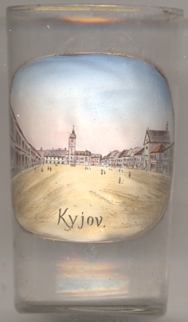

|
| ČESKÁ REPUBLIKA | CZECH REPUBLIC |
| Jihomoravský kraj | South Moravia (Brno) region |
| Okres: Hodonín |
 Kyjov (German: Gaya or older Geyen) is situated at an elevation of 192 m on the river Kyjovka, about 18 km north
of the district town Hodonín and about 44 km southeast of the regional capital Brno.
The municipality has a population of about 10,800 (2023) and also includes the villages Bohuslavice (Bohuslawitz), Boršov (Borschau) and
Nětčice (Nietschitz).
Kyjov (German: Gaya or older Geyen) is situated at an elevation of 192 m on the river Kyjovka, about 18 km north
of the district town Hodonín and about 44 km southeast of the regional capital Brno.
The municipality has a population of about 10,800 (2023) and also includes the villages Bohuslavice (Bohuslawitz), Boršov (Borschau) and
Nětčice (Nietschitz).
Archeological finds show that tha area had been inhabited at least since the Paleolithic period. The first written mention of Kyjov dates from 1126. Until 1539, it was a property of the monastery at Hradisko near Olomouc. In 1201 Kyjov was mentioned for the first time as a market town. In 1284 it received the privilege of being fortified. However, as the town did not have sufficient funds, only wooden palisades were built. Due to financial difficulties of the monastery, in the 14th and 15th centuries, Kyjov was pawned to various lower nobles. In 1515, Kyjov obtained the privileges of a town. After the monastery had sold the town in 1529, the ownership changed again several times. In 1548 it obtained the status of a royal town, associated with the promise not to be sold or pawned again. In 1710, the first Capuchins came to Kyjov. However, the Capuchin monastery was abolished in 1784. From 1784 to 1848, the town was in good economic condition and expanded. In the second half of the 19th century, Kyjov had a German speaking minority, which included a Jewish population. Until 1918, Gaya – Kyjov (Gaya in Mähren) was part of the Austro-Hungarian monarchy (Austrian side after the compromise of 1867) and capital of a district of the same name. In the second half of the 19th century, the railway from Austerlitz (Slavkov u Brna) via Gaya to Bisenz was built, and in 1899 the Brno Local Railway Company built the branch line to Mutěnice. During the German occupation during World War II, the Nazis deported the Jewish population and murdered most of them. After World War II and the foundation of the Czechoslovak Republic, the remaining German population was expelled. The district Kyjov existed until 1960 when it was merged into the district Hodonín.
The  town hall [left, no. 4440: background centre] was built in Renaissance style in 1561/1562
by Italian architects. It is decorated by sgraffiti and has a 39-metres-high tower.
town hall [left, no. 4440: background centre] was built in Renaissance style in 1561/1562
by Italian architects. It is decorated by sgraffiti and has a 39-metres-high tower.
[https://de.wikipedia.org/wiki/Kyjov, https://en.wikipedia.org/wiki/Kyjov]
![[scale]](lineal.jpg)